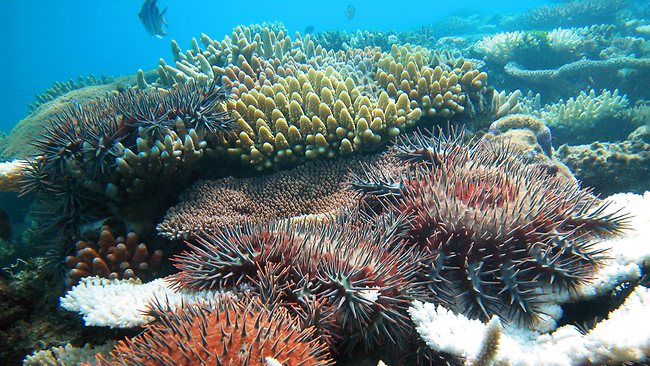
Image: Australian Institute of Marine Science
Ocean Life Education Marine Officer, Meaghan Smith is also a PhD student taking part in an important research project to help save the Great Barrier Reef.
We asked Meaghan to share a bit about her research with us…
What are you researching?
I am currently mid-way through my PhD in Molecular Biology studies at the University of the Sunshine Coast in collaboration with the Australian Institute of Marine Science, with a project focusing on the neural biology of the Crown of Thorns Starfish (COTS), Acanthaster planci.
What’s the problem?
The aim of my PhD is to elucidate the neural peptides involved in the biology and physiology of these coral eating critters on the Great Barrier Reef!
With the Crown of Thorns Starfish outbreaks a continuous threat to the reef, my project explores the molecular basis of reproduction and chemical signaling molecules used by the COTS during events such as aggregation and spawning in aide of developing novel biocontrol methods. Although there are emerging technologies and methods to control COTS numbers on the reef, there still remain gaps in the knowledge surrounding the COTS biology.
What do we know about Crown of Thorns Starfish?
- COTS are avid coral feeders, with an adult animal capable of consuming up to 10m2 of coral annually.
- Due to their venom, COTS have very few predators. One predator with key biological attributes in conquering the COTS is the Giant Triton Snail- however due to overfishing the dwindling numbers of tritons on the reef escalates the problem.
- COTS are the most fecund of echinoderms with an adult female capable of spawning up to 150 million eggs per season.
- COTS are seasonal broadcast spawners with the reproductive season being the warmer summer months in Australia. During reproductive season, COTS are noticed to aggregate together and display a synchronized spawning event. The males will synchronise their spawning, with the surrounding females spawning within 30 minutes of this event. It is believed the COTS fertility success rate exceeds 70%. This may be due to increased algal feed for juvenile seastars which contributes to the success.
- COTS appear to survive months without any feed (up to 12 months in my current laboratory studies). This is concerning as it demonstrates COTS can withstand hostile environments whilst still maturing reproductively.
- COTS outbreaks are a natural occurrence of the reef ecosystem- however numbers on the northern great barrier reef are currently catastrophic. This is a controversial issue with theories suggesting increased nutrients in the water could be a factor contributing to the population success, as is the increase in ocean temperatures due to increased viable algal feed for juveniles.
What do you hope to achieve?
My aim is to gain a greater understanding of the neuropeptides and neurotransmitters used by COTS for this maturation, aggregation, spawning and reproductive physiology. Initial results are revealing some very exciting and unique biological attributes to the COTS and will hopefully aid in future control of the COTS crisis!
Thanks for sharing your incredible insights with us, Meaghan. Keep up the great work!
Meaghan recently featured on Channel Ten’s Totally Wild television program.
Check out our range of Programs for schools and early learners to learn more about the marine environment!


